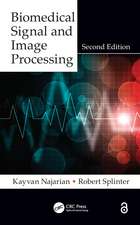Recognition Receptors in Biosensors
Editat de Mohammed Zouroben Limba Engleză Paperback – 22 aug 2016
| Toate formatele și edițiile | Preț | Express |
|---|---|---|
| Paperback (1) | 1441.52 lei 6-8 săpt. | |
| Springer – 22 aug 2016 | 1441.52 lei 6-8 săpt. | |
| Hardback (1) | 1446.82 lei 3-5 săpt. | |
| Springer – 9 mar 2010 | 1446.82 lei 3-5 săpt. |
Preț: 1441.52 lei
Preț vechi: 1517.40 lei
-5% Nou
Puncte Express: 2162
Preț estimativ în valută:
275.83€ • 288.77$ • 228.23£
275.83€ • 288.77$ • 228.23£
Carte tipărită la comandă
Livrare economică 05-19 aprilie
Preluare comenzi: 021 569.72.76
Specificații
ISBN-13: 9781493939404
ISBN-10: 1493939408
Pagini: 880
Ilustrații: XVI, 863 p.
Dimensiuni: 155 x 235 x 44 mm
Greutate: 1.21 kg
Ediția:Softcover reprint of the original 1st ed. 2010
Editura: Springer
Colecția Springer
Locul publicării:New York, NY, United States
ISBN-10: 1493939408
Pagini: 880
Ilustrații: XVI, 863 p.
Dimensiuni: 155 x 235 x 44 mm
Greutate: 1.21 kg
Ediția:Softcover reprint of the original 1st ed. 2010
Editura: Springer
Colecția Springer
Locul publicării:New York, NY, United States
Cuprins
Sensor Surface Chemistry and Receptor Immobilization.- Principles of Biomolecular Recognition.- Surface Sensitization Techniques and Recognition Receptors Immobilization on Biosensors and Microarrays.- Analytical Tools for Biosensor Surface Chemical Characterization.- Natural Recognition Receptors.- Enzyme for Biosensing Applications.- Antibodies in Biosensing.- Peptides as Molecular Receptors.- Carbohydrates as Recognition Receptors in Biosensing Applications.- Nucleic Acid Diagnostic Biosensors.- Tissue-Based Biosensors.- Biosensing with Plants: Plant Receptors for Sensing Environmental Pollution.- Bacteriophage-Based Biosensors.- Synthetic and Engineered Receptors.- Antibody Engineering for Biosensor Applications.- Genetically Engineered Proteins as Recognition Receptors.- Biosensing Systems Based on Genetically Engineered Whole Cells.- Photosynthetic Proteins Created by Computational and Biotechnological Approaches in Biosensing Applications.- Oligonucleotides as Recognition and Catalytic Elements.- Aptamers: Versatile Tools for Reagentless Aptasensing.- Phage Display Technology in Biosensor Development.- Molecularly Imprinted Polymer Receptors for Sensors and Arrays.- Biomimetic Synthetic Receptors as Molecular Recognition Elements.- Kinetics of Chemo/Biosensors.- Kinetics of Chemo/Biosensors.
Textul de pe ultima copertă
This book presents a significant and up-to-date review of various recognition receptors, their immobilization, and an overview of surface characterization techniques. Distinguished scientists from key institutions worldwide have contributed chapters that provide a deep analysis of their particular subjects; at the same time, each topic is framed within the context of this integrated approach. This work explores comprehensively the field of recognition receptors, presenting a thorough review of the subject and effective integration of these receptors on sensor surfaces in order to appropriately convey state-of the-art fundamentals and applications of the most innovative approaches.
The book consists of four parts:
The first part comprises three chapters, which are devoted to the introduction of biomolecular recognition, surface sensitization and recognition receptors immobilization, as well as containing an overview of the analytical tools that can be used for surface characterization.
The second part describes the different natural recognition receptors (enzymes, antibodies, cells, tissues, plant tissues, peptides, bacteriophages and photosynthetic proteins) currently used in the field of biosensors and microarrays. It covers the theory behind each technique and delivers a detailed state-of-the-art review for each new technology.
The third part covers the recognition receptors that can be prepared and tailored by man to mimic natural molecules used in biosensors and microarrays. It describes in detail the use of engineered antibodies, carbohydrates, nucleic acids, oligonucleotides, aptamers, genetically engineered cells, genetically engineered proteins, phage display, molecularly imprinted polymers, and biomemetic materials as recognition elements.
The fourth part contains one chapter that briefly covers the kinetics and thermodynamics of association/dissociation of analytes to the recognition receptors on sensor surfaces.
Students and researchers who need a solid foundation or reference, and practitioners interested in discovering more about what is state-of-the-art in the field of recognition receptors will find this book invaluable. This book is written for academics, from undergraduate and postgraduate students upward, working in areas related to chemical/bio-sensors. It would be an important reference for, but not limited to, professionals working in varied fields including biology, biotechnology, biochemistry, analytical chemistry, biomedicine, physical chemistry, microsystem engineering, nanotechnology, veterinary, food QA, bioterrorism and security, as well as health surveillance. The book has more than 150 illustrations and figures to help explain and clarify the ideas presented.
The book consists of four parts:
The first part comprises three chapters, which are devoted to the introduction of biomolecular recognition, surface sensitization and recognition receptors immobilization, as well as containing an overview of the analytical tools that can be used for surface characterization.
The second part describes the different natural recognition receptors (enzymes, antibodies, cells, tissues, plant tissues, peptides, bacteriophages and photosynthetic proteins) currently used in the field of biosensors and microarrays. It covers the theory behind each technique and delivers a detailed state-of-the-art review for each new technology.
The third part covers the recognition receptors that can be prepared and tailored by man to mimic natural molecules used in biosensors and microarrays. It describes in detail the use of engineered antibodies, carbohydrates, nucleic acids, oligonucleotides, aptamers, genetically engineered cells, genetically engineered proteins, phage display, molecularly imprinted polymers, and biomemetic materials as recognition elements.
The fourth part contains one chapter that briefly covers the kinetics and thermodynamics of association/dissociation of analytes to the recognition receptors on sensor surfaces.
Students and researchers who need a solid foundation or reference, and practitioners interested in discovering more about what is state-of-the-art in the field of recognition receptors will find this book invaluable. This book is written for academics, from undergraduate and postgraduate students upward, working in areas related to chemical/bio-sensors. It would be an important reference for, but not limited to, professionals working in varied fields including biology, biotechnology, biochemistry, analytical chemistry, biomedicine, physical chemistry, microsystem engineering, nanotechnology, veterinary, food QA, bioterrorism and security, as well as health surveillance. The book has more than 150 illustrations and figures to help explain and clarify the ideas presented.
Caracteristici
Includes supplementary material: sn.pub/extras












